18.1: The Aging Population
18.1.1: Aging
Aging is the process of people growing older.
Key Points
- Population aging is a demographic phenomenon which involves the rise in the median age of a country or region.
- Traditionally, the extended family was primarly responsible for taking care of the elderly, a fact which is no longer the case in many societies.
- Today, the state and various charitable organizations are largely responsible for providing care for the elderly.
- In the U.S., two major problems associated with an aging population are the pension crisis and the strain on the healthcare system, particularly Medicare.
Key Terms
- Growing Old
-
In the 1961 book Growing Old, Cumming and Henry formulated the disengagement theory of aging. It was the first theory of aging that social scientists developed.
- disengagement theory
-
The disengagement theory of aging states that “aging is an inevitable, mutual withdrawal or disengagement, resulting in decreased interaction between the aging person and others in the social system he belongs to.”
Aging
As people grow older, they become less self-sufficient in terms of taking care of their own finances, health, and general day-to-day needs and obligations. For example, most societies have a generally accepted age of retirement (based on both societal norms as well as a country’s tax laws and pension rules) after which point an individual ceases to engage in employment. The rest of society typically assumes some level of responsibility in ensuring that the elderly are cared for. The elderly can receive care from a variety of different sources, including their families, the state, the private sector, and charitable institutions. Nevertheless, even in societies that have a strong system in place to provide for the aged, an aging population poses a significant financial and economic burden . In the U.S. specifically, the pension system and the healthcare sector are two important examples of this problem.
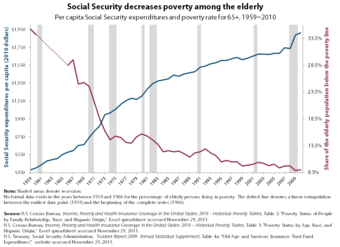
Does Social Security Decrease Poverty among the Elderly?
The blue line represents social security expenditure in 2010 dollars, while the red line indicates the percentage of the population aged 65 and over who are at or below the poverty line. As the graph shows, the amount of social security expenditure is correlated with a drop in the number of elderly people at or below the poverty line.
History of Elderly Care
Traditionally, the extended family would look after the older generation. While this role is still attributed to the family in many parts of the world, particularly in non-Western nations, the modern family has evolved in such a way that care for the aged is now provided for by the state and various charitable organizations. Some of the main reasons why elders are less likely to be taken care of exclusively by their families include the decreasing size of families, the increased longevity of the elderly, the geographic dispersion of families, and the fact that women have become more educated and commonly work outside the home. While this trend is widespread in Europe and North America, there is growing evidence of it in many parts of Asia, too. The various forms that elderly care services can take include assisted living, adult day care, long-term care, nursing homes, hospice care, and in-home care. The different institutions can further be classified as medical (skilled) care and non-medical (social) care.
Several countries today are facing an aging population, where the median age of the population has increased and a larger portion of the population is considered to be older. Two primary reasons for this are increased life expectancy and lower birth rates. Currently, the majority of the countries facing this demographic phenomenon consists of advanced economies, such as Japan and many parts of Europe. However, it is predicted that the greatest future impact will occur in Asia.
Advantages of an Older Population
There may be some economic advantages to having an older population. For example, since older people have higher accumulated savings per head than younger individuals do, a large aged population can result in lower interest rates as well as a lower rate of inflation. However, for the most part, a substantial aged population leads to a lot of financial pressure on both the public and private sectors.
Disadvantages of an Older Population
One of the problems that may arise from a large segment of society being aged is a pension crisis. In the U.S., it is probably going to become increasingly difficult to pay corporate, federal, and state pensions, because the number of workers relative to retirees is shrinking. In order to improve the sustainability of the pension system, a few measures can be undertaken. For example, the worker-retiree ratio can be rectified by increasing the retirement age or by changing employment and immigration policies. Alternatively, it may be possible to reduce the amount owed to retirees. Finally, it may become necessary to expand resources to fund pensions through increased contributions or higher taxes. Trying to implement any of these solutions will likely result in some level of controversy and public debate.
Another significant source of problems related to an older population resides in the healthcare sector. In 1965, Congress created Medicare under the Social Security Act in order to provide health insurance to U.S. citizens over the age of 65, regardless of their income and medical history. Aside from premiums paid by Medicare enrollees along with the fund source itself, Medicare is financed by revenue levied on employers and workers through the Federal Insurance Contributions Act and the Self-Employment Contributions Act. However, due to rising enrollment as the population ages and a decreasing ratio of workers to enrollers, Medicare is facing financial difficulties. While the Patient Protection and Affordable Care Act is supposed to address many issues confronting the healthcare sector today, the rising cost of healthcare remains a national problem, as patients are paying more in order to receive the same care as before.
18.1.2: Composition of the Older Population
The elderly proportion of the population is growing around the world, but it is greater in developed countries.
Learning Objective
Examine the sociological factors that allow people to live longer lives in industrialized versus non-industrialized nations, such as better access to health care
Key Points
- All over the world, people are living longer. Population experts estimate that more than 50 million Americans, or 17 percent of the population, will be 65 or older in 2020.
- Biological markers for old age (such as wrinkles, grey hair, memory loss, etc.) exist, but old age can also be defined by when an individual begins to fill certain social roles, such as becoming a grandparent or retiring.
- There is a disparity between industrialized and non-industrialized nations; people live longer in industrialized countries.
- The population of people aged 65 and older has been growing at a faster rate than the total population. While women still live longer than men, the gender gap among seniors is narrowing.
- There appear to be regional divides in the demographic breakdown of senior citizens.
Key Terms
- centenarian
-
Being at least 100 years old.
- United States Census
-
The United States Census provides more specific information about the make up of older Americans. According to the census, there has been rapid growth amongst the elderly segment of the population in recent years.
The number of individuals living into old age is growing worldwide. While the trend of an aging population is obvious, it can be difficult to assess because the definition of “old age” depends entirely on the cultural norms of a given society. Biological markers for old age (such as wrinkles, grey hair, memory loss, etc.) exist, but old age can also be defined by when an individual begins to fill certain social roles, such as becoming a grandparent or retiring. All of these factors vary by culture.
Statistics on Age
Nevertheless, the fact is that people are living longer and are therefore more prone to encounter issues associated with old age. In industrialized nations, life expectancy has increased consistently over the last decades. In the United States, the proportion of people aged 65 or older increased from 4 percent in 1900 to about 12 percent in 2000. In 1900, only about 3 million Americans were 65 or older, out of a total population of 76 million Americans. By 2000, the number of senior citizens had increased to 35 million out of 280 million Americans. Population experts estimate that more than 50 million Americans, or 17 percent of the population, will be 65 or older in 2020. The number of older Americans has spiked in recent years due to the age of baby boomers—the generation that was born in the twenty years following World War II. As soldiers returned from war, families began to grow. This generation is now beginning to enter their older years.
The United States Census provides more specific information about the make up of older Americans. According to the census, there has been rapid growth among the elderly segment of the population in recent years. The population of people aged 65 and older grew at a faster rate than the total population. While women still live longer than men, the gender gap among seniors is narrowing. Further, there appear to be regional divides in the demographic breakdown of senior citizens. The South had the largest number of people aged 65 and up, while the Northeast had the largest percentage of people aged 65 and up. In 2010, 53,364 centenarians, or people over the age of 100, lived in the United States, a 5.8 percent increase from the number of centenarians in 2000. This means that 1 out of every 5,786 Americans is over the age of 100.
While the trend of an older population appears worldwide, people in industrialized nations are older than people in non-industrialized nations. While people in almost all countries are living longer than prior generations, people in industrialized nations still live longer than people in non-industrialized nations. According to the Population Research Bureau, the average life expectancy in Africa is 53, in North America is 78, in Latin America is 73, in Asia is 68, in Europe is 75, and in Oceania is 75. Some of this difference can be attributed to disparities in health care—easier access to pervasive biotechnology in industrialized nations means that people live longer. Other factors include poverty and a generally more strenuous lifestyle, which can cause health problems and a lower life expectancy.
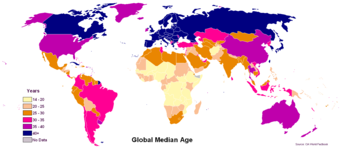
Global Median Age
Average age by country
18.1.3: Gender Differences in Aging
Aging to sex ratios show women living longer than men, but this gap has been quickly narrowing since 1990.
Learning Objective
Analyze the gender gap that exists leading to women generally living longer than men
Key Points
- Women tend to live longer than men, and the ratio of women to men is high among the elderly.
- The percentage of men aged 65 and up grew faster than the percentage of women aged 65 and up, according to the 2010 census.
- The longevity of women relative to men is likely due to their better cardiovascular health, the fact that they are less likely to engage in risky behavior, and the fact that traditionally, physical labor is more frequently performed by men.
Key Term
- centenarian
-
Being at least 100 years old.
Women tend to live longer than men in almost every country. In Japan, men generally live to about 79, whereas women live to 83. However, in the United States, that gender gap is beginning to close. The percentage of men aged 65 and up grew faster than the percentage of women aged 65 and up, according to the 2010 census. For example, the number of men aged 85 to 94 grew 46.5% between 2000 and 2010, but the number of women in that age group grew only 22.9%.
However, for the very oldest members of the population, the gender gap still holds true. The United States Census reports that of the 53,364 centenarians, or people over the age of 100, 82.8% are women and only 17.2% are male. In other words, out of the entire American population, 1 out of every 3,551 females is a centenarian while only 1 out or 16,566 males is a centenarian. Thus, even though the gender gap is narrowing, women are still expected to live longer than men .
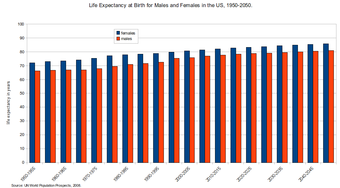
A Comparison of Genders
This graph illustrates the differences in life expectancy at birth for males and females in the United States, from 1950 to 2050.
These figures could be due, in part, to the sex ratio. The sex ratio is the ratio of men to women in a given society or country. The current sex ratio for the world is 986 females to 1000 males. In the United States, the ratio is 105 males to every 100 females. However, men tend to live riskier lives, are more prone to heart disease and cancer, and women are therefore likely to live longer than men. In fact, cancer deaths among men are 200 per 100,000 cases, whereas women are only 150 per 100,000 (from the National Cancer Institute).
Why women live longer than men is not perfectly understood. Several factors contribute to the overall trend. For example, men statistically engage in more behaviors that put their lives at risk than women, which reduces their life expectancy. Men are also more “successful” when attempting suicide, which also brings down their life expectancy. Another factor that may contribute to the greater life expectancy of women is the different types of jobs men and women tend to have during their lifetimes, with men more frequently doing physical labor that could wear the body down or increase the odds of injury. Other biological factors likely play a role, including greater cardiovascular health among women.
18.1.4: Aging and Race
Individuals with different racial backgrounds tend to have different experiences with old age.
Learning Objective
Examine the racial implications of aging, particularly for minority groups
Key Points
- Minority populations are more likely to experience elder abuse from relatives and caretakers.
- Minority populations are also more likely to experience health problems associated with old age.
- Many of the medical differences between different racial groups are better explained by differences in socioeconomic status rather than race.
Key Terms
- social determinants of health
-
The economic and social conditions that influence individual and group differences in health status.
- elder abuse
-
Elder abuse is a general term used to describe certain types of harm to older adults.
Individuals of different racial backgrounds experience aging—and the health issues associated with it—differently . Before turning to the medical concerns that accompany aging, one should note that elders of different racial backgrounds also experience different frequencies of elder abuse. Elder abuse is a general term to describe certain types of harm that are inflicted upon older adults. The most common form of elder abuse is neglect or improper care for vulnerable seniors. Unfortunately, this is usually inflicted by people whom the elder trusts and who are responsible for caring for the elder, such as family members or caretakers at elder homes. Research indicates that black senior citizens are more likely to be abused than white citizens.

Aging and its Trials
Are the problems the elderly face a result of their age, or are their other, more influential, factors involved, such as race?
Further, medical concerns present differently for white seniors and minority seniors. Black and Hispanic seniors are more likely to encounter cardiac problems earlier than white seniors. However, these outcome disparities are not usually the result of biological determinants of health, which means that minority populations are not biologically less healthy than white populations. Rather, the disparity in medical outcomes is more likely attributed to social determinants of health, which are socioeconomic conditions that bear on health.
For example, black and Hispanic populations are more likely to encounter financial hardship and therefore eat less healthy food, which potentially leads to health problems. In addition, individuals from a poorer socioeconomic background are less likely to have had access to healthcare throughout their whole lives. This lack of access ultimately leads to medical concerns in old age. Thus, while one can make generalizations about elder health by comparing racial categories, these differences are frequently caused by differences in socioeconomic status rather than race.
18.1.5: Aging and Wealth
In order to assist the elderly with their living and healthcare costs, the U.S. government established assistance programs like Medicare.
Learning Objective
Examine the programs made available to the elderly to assist with quality of life, such as Social Security and Medicare, and the looming crises with these particular programs
Key Points
- American seniors face serious financial troubles due to the fact that they are no longer earning an income, but face increased expenses as a result of diminishing health.
- Social Security and Medicare are federal programs designed to help seniors, though both programs face financial difficulties themselves.
- The Patient Protection and Affordable Care Act, also known as Obamacare, would help cut down seniors’ expenses by lowering healthcare costs and increasing public services.
Key Terms
- baby boomer generation
-
The baby boomer generation, or those born during the spike in births in the twenty years following World War II, is starting to reach senior citizenship, and will soon pull from the public funds of Social Security and Medicare.
- Obamacare
-
a colloquial term for the Patient Protection and Affordable Care Act of 2010 which expands health care coverage for Americans
- Patient Protection and Affordable Care Act
-
an American law passed in 2010 that expands health care coverage
Managing the Aging Population
The elderly have financial difficulties primarily because they are too old to hold a job, and thus have no regular income, yet they incur large medical expenses as a result of diminishing health. However, due to the improvement in medical technology, more seniors are living longer and more fulfilling lives, yet still struggle financially. Because of this trend of impoverishment, the United States has enacted social policies designed to help the elderly manage their financial woes. Major policy efforts include Social Security, a social welfare program that taxes the current working sector to give money to individuals in retirement, and Medicare, a federal program that subsidizes medical costs for seniors. Prior to the introduction of Social Security, the elderly were the poorest age group in the United States. With the introduction of Social Security, poverty rates of the elderly in the United States have dropped dramatically. Between 1960 and 1995, the official poverty rate of those aged 65 and above fell from 35 percent to 10 percent, according to the National Bureau of Economic Research. However, due to a lack of funds, that number is beginning to increase once again.
Social Security
Social Security is designed to redistribute wealth temporarily in order to help seniors finance their lives after retirement. In this program, the current workforce is taxed, the results of which flow into a special fund designated for Social Security. Payments are then made from this fund to retirees. This is not, however, simple redistribution. The workforce that is currently contributing to the fund will then retrieve payments once they retire. Thus, Social Security has features of both a redistribution system and a savings account.
Medicare
In addition to Social Security, the other primary social support for the American elderly is Medicare. Medicare is a social insurance program that provides health care for American citizens over the age of 65. Medicare subsidizes hospital visits, doctors’ appointments, and prescription drugs. Created in 1965, Medicare was intended to address the fact that seniors spend more on healthcare than any other segment of the population, despite having the least income. Recent studies have confirmed that Medicare enrollees typically have lower incomes and more healthcare expenses than the average American. In 2006, the average household income of Medicare enrollees was $22,600, far less than the median American income of $48, 201. In 2008, 16% of Medicare enrollees were living below the poverty line, compared to 13% of the general population. Further complicating things, the typical senior household has only $66,900 in savings, yet the average American male needs $124,000 to cover healthcare during retirement, and the average American female needs $152,000.
Because Medicare enrollees are, by definition, senior citizens, their healthcare costs also far higher than average. About 87% of Medicare enrollees have at least one chronic condition and close to half have three or more. Thirty percent of enrollees visit the emergency room in any given year, and 21% have an inpatient stay. Roughly 66% of seniors require some form of long-term care over their lifetimes, and 18% live in a nursing home for at least one year. These disparities demonstrate the complicated problems most senior citizens encounter as they age.
Looming Crises with Medicare and Social Security
Social Security could soon be in crisis if current trends to not change. Right now, more money is being garnished through taxing the current workforce than is being paid out to retirees. However, this will soon change. If the laws governing Social Security are not changed by 2017, the program will begin paying out more funds than it receives. Medicare faces even more dire financial problems than Social Security. Like Social Security, Medicare gains revenue through taxation, but by 2009, Medicare was expending more than it was earning, and its Trust Fund had already been tapped to access emergency funds. The Trust Fund for Medicare will be exhausted by 2017, at which point, the federal government will only be able to cover about 80% of the costs of medical treatment for its senior citizens, which is around 48 million Americans.
Part of the reason both Social Security and Medicare face looming crises is the rising population of seniors. The baby boomer generation, those born in the 20 years following World War II, is starting to reach senior citizenship and pull from these public funds. At the same time, the working population in the United States has decreased. Thus, Social Security and Medicare are both being called upon to support greater numbers of senior citizens while having fewer workers to tax in order to gain revenue. The respective conditions of Social Security and Medicare contributed significantly to the discussion surrounding the Patient Protection and Affordable Care Act, passed by President Barack Obama in 2010. The act, commonly referred to as Obamacare, provides a public insurance option through the government to help drive down insurance costs. By lowering healthcare costs and requiring insurance, the government hopes to better address the needs of the nation’s elderly. However, the constitutionality of the Act is currently being debated by the U.S. Supreme Court and the Act could be overturned. Regardless of what the Supreme Court decides, American seniors face serious financial troubles, compounded by their healthcare needs.
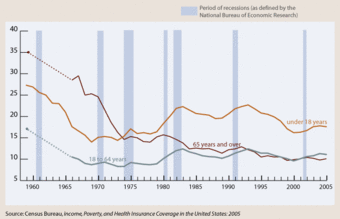
Poverty by Age
This figure shows the relationship between poverty and age.
18.1.6: Global Aging
Global aging differs depending on the access to economic and social resources; thus, industrialized countries tend to have older populations.
Learning Objective
Discuss the impact of an aging population on the economy, for example, in terms of health care costs
Key Points
- People are living longer than ever before across the world.
- However, on average, people in industrialized nations live longer than people in non-industrialized nations. This is largely due to poorer health in non-industrialized countries, and fatalities associated with HIV/AIDS.
- Difference in lifespan is also attributed to better access of healthcare in different industrialized and non-industrialized nations.
- The economic effects of an aging population are considerable.
Key Terms
- biotechnology
-
The use of living organisms (especially microorganisms) in industrial, agricultural, medical and other technological applications
- HIV/AIDS
-
An infectious disease, caused by HIV, that causes the gradual degeneration of the body’s immune system.
Example
- The Chinese government’s strict control over family size, particularly its one-child policy for urban families, has resulted in a significant decrease in the country’s population growth rate. China can expect to confront an aging population in the foreseeable future if this trend, among others, persists.
All over the world, people are living longer than ever before. However, while the trend of a growing older population appears world over, people in industrialized nations are older than people in non-industrialized nations. According to the Population Research Bureau, the average life expectancy in Africa is 53, in North America is 78, in Latin America is 73, in Asia is 68, in Europe is 75, and in Oceania is 75. Worldwide, about 8% of the total global population is over the age of 65, while about 12% of Americans are over the age of 65.
Some of this difference can be attributed to disparities in health care. Easier access to pervasive biotechnology in industrialized nations means that people live longer. Unfortunately, in some countries HIV/AIDS has ravaged the population to the point where the average life expectancy drops. Most of these countries have lower levels of development and industrialization.
The economic effects of an aging population are considerable. Older people have higher accumulated savings per head than younger people, but spend less on consumer goods. Depending on the age ranges at which the changes occur, an aging population may thus result in lower interest rates and the economic benefits of lower inflation. Some economists see advantages in such changes, notably the opportunity to progress automation and technological development without causing unemployment. They emphasize a shift from GDP to personal well-being.
However population aging also increases some categories of expenditure, including some from public finances. The largest area of expenditure in many countries is now health care, the cost of which is likely to increase dramatically as populations age. This would present governments with hard choices between higher taxes, including a possible reweighing of tax from earnings to consumption, and a reduced government role in providing health care.
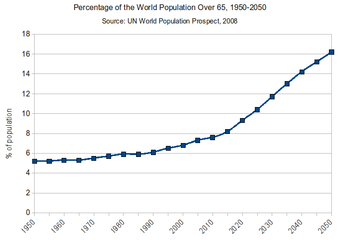
Percentage of the World Population Over 65
1950-2050
18.2: A Global Perspective on Aging
18.2.1: The Social Construction of Aging
The social construction of aging entails the creation of social norms and symbols that encapsulates the aging process.
Learning Objective
Discuss the cultural treatment of aging in the U.S. versus Japan, employing Goffman’s argument in ”The Presentation of Self in Everyday Life”
Key Points
- Age is socially constructed because notions of age vary around the world.
- Different cultures fix age with different meanings and different values.
- Eastern cultures tend to highly value age and wisdom, while Western cultures tend to highly value youth.
- In Western societies, people take pains to appear younger than their biological age. These measures follow Erving Goffman’s ideas of self-presentation in that people are trying to get others in society to perceive them as young.
Key Term
- social construction
-
A concept or practice that is the construct (or artifact) of a particular group, meaning that the concept or practice is understood differently by various groups and institutions.
Example
- Representations of aging in the social life are determined by different social interactions like getting senior discounts. Society has predetermined who is socially able to obtain those discounts based on their age range. Senior citizens are considered old in most cases by the rest of the population in the United States.
Aging as a Social Construction
While aging itself is a biological process, what it means to be “young” or “old” is socially constructed. This means that there is no inherent cultural meaning to the biological process of aging. Rather, cultures imbue youth and age with meanings. Aging is perceived differently around the world, demonstrating its social construction.
Frequently, the average life expectancy in a given region bears on what age counts as “old.” For example, in the United States, where the average life expectancy is over 78 years, people are not considered “old” until they are in their sixties or seventies. However, in Chad the average life expectancy is less than 49 years. People in their thirties or forties are therefore already middle-aged or “old.” These variations in people’s perceptions of who should or should not be considered elderly indicates indicates that notions of youth and age are culturally constructed. There is thus no such thing as a universal age for being considered old .

Is this Incongruous?
Given the socially constructed nature of age, there are certain behaviors that people typically associate with certain age groups as being “appropriate” or “acceptable. ” Is this old woman challenging any conventional perceptions about how women of a certain age should behave?
Cultural Treatment of Aging
Cultures treat their elderly differently and place different values on old age. Many Eastern societies associate old age with wisdom, so they value old age much more than their Western counterparts. In Japan, adult children are expected to care for their aging parents in ways different than in the United States. Sixty five percent of Japanese elders live with their children and very few live in nursing homes. Japanese cultural norms suggest that caring for one’s parents by putting them in an assisted living home is tantamount to neglect. When unable to care for themselves, parents should ideally move in with their children. The Japanese celebration of old age is further illustrated by the existence of Respect for the Aged Day, which is a national holiday to celebrate elderly citizens.
Japanese perceptions of elders diverge markedly from public perceptions of old age in the United States. Western societies tend to place an increased value on youth such that many people take extreme measures to appear young. The desire to look younger than one’s biological years is frequently the impetus for cosmetic surgeries that can hide the physical effects of aging. These surgical practices, combined with the huge expenditures on makeup and clothing in younger fashions, incorporate a Goffmanian understanding of social presentation.
Erving Goffman was a sociologist writing in the mid-twentieth century. His most famous work, The Presentation of Self in Everyday Life (1959) argued that whenever individuals come into contact with other people, they will attempt to control or guide the impression that others might have of them by intentionally comporting themselves in different ways. Individuals thus take sometimes drastic action to control the appearance of their age so that others can perceive them to be younger. Significantly, these social interactions occur in a social milieu that values youth. In this light, people try to appear younger to increase their sense of social value. Of course, interactions involving the perception of age must then vary by culture, as different cultures ascribe the notion of age with different values.
18.2.2: Industrialization and the Graying of the Globe
Industrialization has contributed to the growth of the older age population due to the technological advances that have come with it.
Learning Objective
Produce a short debate which shows the pros and cons of industrialization
Key Points
- Industrialized nations are those that meet certain measures of economic growth and security, while non-industrialized nations are those that do not meet those measures.
- Industrialization increases life expectancy by creating better conditions, better government social supports, and better access to healthcare.
- There is currently a disparity in life expectancy between industrialized nations and non-industrialized nations.
Key Terms
- Industrial Revolution
-
The major technological, socioeconomic, and cultural change in the late 18th and early 19th century, resulting from the replacement of an economy based on manual labor to one dominated by industry and machine manufacturing.
- industrialized countries
-
Industrialized countries are defined by measures of economic growth and security. Most commonly, the criteria for evaluating the degree of development is to look at the gross domestic product (GDP), the per capita income, the level of industrialization, the amount of widespread infrastructure, and the general standard of living.
- infant mortality rate
-
In the field of public health, the infant mortality rate is a commonly used statistical measure that is defined as the ratio of infant deaths to live births.
Example
- As Malaysia has a life-expectancy of close to 76 years and a declining birth rate, the Malaysian Trade Union Congress (MTUC) is encouraging a Minimum Retirement Age Bill in Congress. Since an aging population presents a financial burden, making workers work longer would allow them to be taxed longer. Other countries in the region, including Singapore, Laos, Thailand, and the Philippines already have a retirement age to address these same issues.
Across the globe, industrialization increases the average life span of people. Industrialization is the process of social and economic change that transforms a community from an agrarian society into an industrial one. It is a part of a wider modernization process, where social change and economic development are closely related with technological innovation. The United Kingdom began an Industrial Revolution in the mid-eighteenth century due to the availability of land, labor, and investment capital.
Most Western countries industrialized by the nineteenth century but the Industrial Revolution is still occurring around the world. One schematic by which one can divide the world is between industrialized and non-industrialized countries. Industrialized countries are defined by measures of economic growth and security. Most commonly, the criteria for evaluating the degree of development is to look at the gross domestic product (GDP), the per capita income, the level of industrialization, the amount of widespread infrastructure, and the general standard of living. Countries that score poorly on these scales are considered to be non-industrialized, though it should be noted that non-industrialized countries are undergoing the process of industrialization.
All over the world, people are living longer than ever before. However, while the trend of a growing older population appears the world over, people in industrialized nations are older than people in non-industrialized nations. Thus, while people in all countries are living longer than prior generations, people in industrialized nations live longer than people in non-industrialized nations. According to the Population Research Bureau, the average life expectancy in Africa is 53, in North America is 78, in Latin America is 73, in Asia is 68, in Europe is 75, and in Oceania is 75. Worldwide, about 8% of the total global population is over the age of 65, while about 12% of Americans are over the age of 65.
How can one explain this disparity? Industrialization brings money into an economy. With this influx of capital, countries are able to develop more robust social supports to assist a population. Further, development can create jobs, enabling people to better fend for themselves. Food and healthcare are more widely available. Better living conditions and healthcare both limit the infant mortality rate, which is the percentage of children who die before turning one year old, and extend the average life expectancy. Both of these trends encourage the growth of an older population.

Industrialized Nations
2011
18.2.3: The Graying of America
The graying of America has contributed to the higher concentration of the elderly in certain areas of the United States.
Learning Objective
Summarize how the situation in Pittsburgh illustrates the economic tensions produced by an aging population
Key Points
- About 12% of Americans are over the age of 65. The elderly are concentrated in the Midwest and the South.
- The higher concentration of older people in certain places has economic ramifications. These areas are called upon to support a population that has a greater need for social services, such as healthcare.
- As the aging population rises in Pittsburgh, industries such as healthcare have replaced the steel industry due to the shift to a more elderly population in that area.
Key Term
- pension
-
A gratuity paid regularly as a benefit due to a person in consideration of past services; notably to one retired from service, on account of retirement age, disability or similar cause; especially a regular stipend paid by a government to retired public officers, disabled soldiers; sometimes passed on to the heirs, or even specifically for them, as to the families of soldiers killed in service.
According to the United States Census, about 12% of the American population is over the age of 65. However, the elderly are not evenly distributed throughout the United States . There are higher concentrations of the elderly in the Midwest and in the South, particularly in Florida. The high concentration of elderly in Florida is partially attributable to the fact that many retirees move to Florida for the good weather. In contrast, few elderly people move to the Midwest. Instead, the high concentration of elderly people in the Midwest is due to the fact that the young are moving out of there.

Percentage of the Population Aged 65+ in the United States
This is a map of the USA reflecting the percentage of the population over age 65 by census district based on Census 2000 data.
The city of Pittsburgh offers an intriguing case study of the effects of an aging population on a city. Since 2008, more people die annually in Pittsburgh than are born. Further, many members of the younger generation are moving away from Pittsburgh in an effort to find work. As such, Pittsburgh is both experiencing population decline and the aging of its existing population. This poses an economic conundrum in that the population is increasingly reliant on public services for assistance, such as healthcare, but there is a smaller workforce that can be taxed to support the demand. Additionally, changing demographics have influenced the comparative prominence of different economic sectors in Pittsburgh. Healthcare has replaced steel as Pittsburgh’s largest industry. This case study demonstrates how shifting population demographics can seriously impact an urban area’s economy.
While the effects of an increasingly aging population on society are complex, there is a specific concern about the impact on healthcare demand. Older people generally incur more health-related costs than do younger people, and in the workplace can also cost more in worker’s compensation and pension liabilities.
18.3: The Functionalist Perspective on Aging
18.3.1: Disengagement Theory
The disengagement theory of aging claims that it is natural and acceptable for older adults to withdraw from society and personal relationships as they age.
Learning Objective
Analyze the nine postulates of growing old and the impact at each stage for the elderly in society
Key Points
- Disengagement theory claims that it is natural and acceptable for older adults to withdraw from society and personal relationships as they age.
- Disengagement theory was the first theory of aging developed by social scientists.
- The theory was developed by Elaine Cumming and Warren Earl Henry in their 1961 book “Growing Old. ” Subsequently, the theory has been largely debunked.
Key Terms
- Robert J. Havighurst
-
Robert James Havighurst (June 5, 1900 in De Pere, Wisconsin – January 31, 1991 in Richmond, Indiana) was a professor, physicist, educator, and aging expert.
- activity theory
-
Activity theory claims that staying mentally and physically active preserves older adults happier.
- disengagement theory
-
The disengagement theory of aging claims that it is natural and acceptable for older adults to withdraw from society and personal relationships as they age.
The disengagement theory of aging claims that it is natural and acceptable for older adults to withdraw from society and personal relationships as they age. The theory further suggests that society responds to the elder’s disengagement with a sort of mutual recognition that the elder will soon pass and society must prepare to function in their absence. As such, the theory argues that it is natural and acceptable for older adults to withdraw from society.
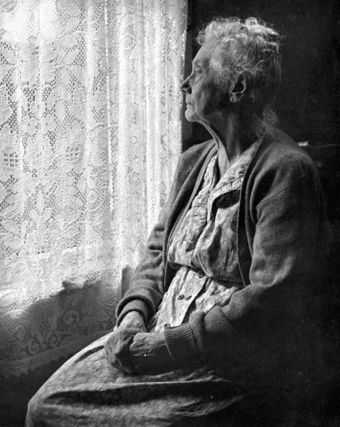
Elderly Woman
Disengagement theory suggests that adults become increasingly withdrawn as they get older.
The Postulates of Growing Old
Disengagement theory was the first theory of aging developed by social scientists. It was originally formulated by Elaine Cumming and Warren Earl Henry in their 1961 book Growing Old. In Growing Old, Cumming and Henry develop a logical argument for why older adults would naturally disengage from society. They formulate their argument along nine postulates to explain why it is rational for individuals who know that death is approaching and who have seen friends of their age pass to begin to anticipate their own deaths and disengage.
The postulates are as follows:
- Postulate one: Everyone expects death, and one’s abilities will likely deteriorate over time. As a result, every person will lose ties to others in his or her society.
- Postulate two: Because individual interactions between people strengthen norms, an individual who has fewer varieties of interactions has greater freedom from the norms imposed by interaction. Consequently, this form of disengagement becomes a circular or self-perpetuating process.
- Postulate three: Because men have a centrally instrumental role in America, and women a socioemotional one, disengagement differs between men and women.
- Postulate four: The individual’s life is punctuated by ego changes. For example, aging, a form of ego change, causes knowledge and skill to deteriorate. However, success in an industrialized society demands certain knowledge and skill. To satisfy these demands, age-grading ensures that the young possess sufficient knowledge and skill to assume authority and that the old retire before they lose their skills. This kind of disengagement is affected by the individual, prompted by either ego changes or the organization, which is bound to organizational imperatives, or both.
- Postulate five: When both the individual and society are ready for disengagement, complete disengagement results. When neither is ready, continuing engagement results. When the individual is ready and society is not, a disjunction between the expectations of the individual and of the members of this social systems results, but engagement usually continues. When society is ready and the individual is not, the result of the disjunction is usually disengagement.
- Postulate six: Man’s central role is work, and woman’s is marriage and family. If individuals abandon their central roles, they drastically lose social life space, and so suffer crisis and demoralization unless they assume the different roles required by the disengaged state.
- Postulate seven: Readiness for disengagement occurs if the individual is aware of the shortness of life and scarcity of time, the individual perceives his or her life space decreasing, and the individual loses ego energy. Each level of society grants individuals permission to disengage because of the following: requirements of the rational-legal occupational system in an affluent society; the nature of the nuclear family; and the differential death rate.
- Postulate eight: Fewer interactions and disengagement from central roles lead to the relationships in the remaining roles changing. In turn, relational rewards become more diverse, and vertical solidarities are transformed to horizontal ones.
- Postulate nine: Disengagement theory is independent of culture, but the form it takes is bound by culture.
Disengagement theory, suffering from a lack of empirical support, has largely been dismissed by social scientists and gerontologists.
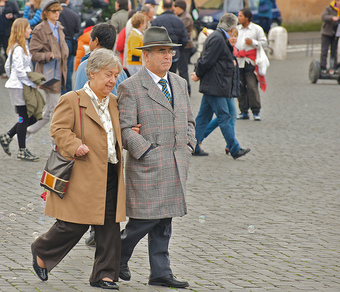
Sunday Morning Stroll in Piazza del Popolo
The process of aging is greatly facilitated when older people pursue hobbies and relationships, and generally lead a more active lifestyle.
18.3.2: Activity Theory
Activity theory proposes that successful aging occurs when older adults stay active and maintain social interactions.
Learning Objective
Compare the activity model and disengagement model of aging, in terms of activity level and level of life satisfaction
Key Points
- The activity theory of aging proposes that older adults are happiest when they stay active and maintain social interactions.
- The theory was developed by Robert J. Havighurst as a response to the disengagement theory of aging.
- The disengagement model suggests that it is natural for the elderly to disengage from society as they realize that they are ever nearer to death.
Key Terms
- Robert J. Havighurst
-
Robert James Havighurst (June 5, 1900 in De Pere, Wisconsin – January 31, 1991 in Richmond, Indiana) was a professor, physicist, educator, and aging expert.
- activity theory
-
Activity theory proposes that successful aging occurs when older adults stay active and maintain social interactions.
- disengagement theory
-
The disengagement theory of aging states that “aging is an inevitable, mutual withdrawal or disengagement, resulting in decreased interaction between the aging person and others in the social system he belongs to.”
The activity theory of aging proposes that older adults are happiest when they stay active and maintain social interactions. These activities, especially when meaningful, help the elderly to replace lost life roles after retirement and, therefore, resist the social pressures that limit an older person’s world. The theory assumes a positive relationship between activity and life satisfaction. Activity theory reflects the functionalist perspective that the equilibrium, that an individual develops in middle age, should be maintained in later years. The theory predicts that older adults that face role loss will substitute former roles with other alternatives.
The theory was developed by gerontologist, or, scholar of aging, Robert J. Havighurst in 1961, and was originally conceived as a response to the recently published disengagement theory of aging. The disengagement model suggests that it is natural for the elderly to disengage from society as they realize that they are ever nearer to death. However, withdrawing from their central societal roles—working, marriage, raising a family—means they drastically lose social life space and so suffer crisis and demoralization.
Havighurst’s activity theory is at deliberate odds with what some perceive as the pessimism of disengagement theory. However, critics of activity theory state that it overlooks inequalities in health and economics that hinders the ability for older people to engage in such activities. Also, some older adults do not desire to engage in new challenges.
Five decades of gerontological research, however, suggest that the activity model is more accurate than the disengagement model . Not only is activity beneficial for the community, but it engages older adults (both physically and mentally) and allows them to socialize with others. This increases feelings of self-worth and pleasure, which are important for happiness and longevity.
18.3.3: Continuity Theory
The continuity theory proposes that older adults maintain the same activities, behaviors, personalities, and relationships of the past.
Learning Objective
Examine the pros and cons of the continuity theory of aging, specifically in terms of how it neglects to consider social institutions or chronically ill adults
Key Points
- Internal structures of continuity remain constant over a lifetime and include elements, such as personality traits, ideas, and beliefs. It helps people make future decisions by providing them with a stable foundation in the past.
- External structures of continuity help maintain a stable self-concept and lifestyle and include relationships and social roles.
- George L. Maddox and Robert Atchley are most closely associated with the continuity theory.
- The theory is criticized for including a distinction between normal and pathological aging that does not take into account older adults with chronic diseases. The theory is also criticized for not considering the influence of social institutions on the aging of individuals.
Key Terms
- Continuity Theory
-
The continuity theory of normal aging states that older adults will usually maintain the same activities, behaviors, personality traits, and relationships as they did in their earlier years of life.
- External Structures
-
(of an individual) consist of relationships and social roles, and support the maintenance of a stable self-concept and lifestyle.
- Internal Structures
-
(of an individual) remain relatively constant throughout a person’s lifetime and includes elements such as personality traits, ideas, and beliefs.
The continuity theory of normal aging states that older adults will usually maintain the same activities, behaviors, personality traits, and relationships as they did in their earlier years of life . The theory considers the internal structures and external structures of continuity to describe how people adapt to their circumstances and set their goals.
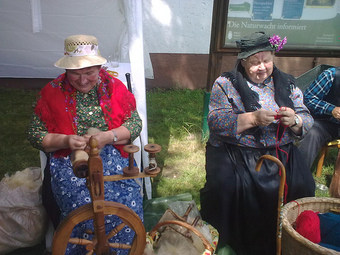
The Internal and External Structures of Continuity
Older adults hold on to many of the beliefs, practices, and relationships they had in the past as they continue to age.
The internal structure of an individual – for instance, an individual’s personality traits – remains relatively constant throughout a person’s lifetime. Other internal aspects such as beliefs can remain relatively constant as well, though are also subject to change. This internal structure facilitates future decision-making by providing the individual with a strong internal foundation of the past. The external structure of an individual consists of relationships and social roles, and it supports the maintenance of a stable self-concept and lifestyle.
George L. Maddox and Robert Atchley are most closely associated with the continuity theory. Maddox provided an empirical description of the continuity theory in 1968 in a chapter of the book Middle Age and Aging: A Reader in Social Psychology called “Persistence of Lifestyle among the Elderly: A Longitudinal Study of Patterns of Social Activity in Relation to Life Satisfaction. ” In 1971, Atchley formally proposed the theory in his article “Retirement and Leisure Participation: Continuity or Crisis? ” He continued to expound upon the theory over the years, explaining the development of internal and external structures in 1989 and publishing a book in 1999 called Continuity and Adaptation in Aging: Creating Positive Experiences.
The theory is criticized primarily for its definition of normal aging. The theory distinguishes between normal aging and pathological aging, so it neglects older adults who suffer from chronic illness. The theory also fails to explain how social institutions impact individuals and the way they age.
18.4: The Conflict Perspective on Aging
18.4.1: Social Security Legislation
Social security refers to legislation enacted by a government to promote the welfare of its population.
Learning Objective
Discuss the development of Social Security to benefit elderly Americans, and the implications for the future of Social Security if it remains the same
Key Points
- The provision of social security by a government to its citizens is included in Article 22 of the Universal Declaration of Human Rights.
- What a particular government does to promote its citizens’ welfare varies widely by country. Many European nations, such as France, have broad social security programs designed to help families, the impoverished, and the elderly.
- In the United States, social security refers to the social insurance program funded through payroll taxes that helps Americans save for retirement.
- Social security is largely credited with significantly reducing poverty rates among the elderly. However, the structure of the social security system has put the entire program into serious financial distress.
Key Terms
- Social Security
-
A system whereby the state either through general or specific taxation provides various benefits to help ensure the well-being of its citizens.
- New Deal
-
The New Deal was a series of economic programs implemented in the United States between 1933 and 1936. They involved presidential executive orders or laws passed by Congress during the first term of President Franklin D. Roosevelt.
- Social Security Act
-
The Social Security Act, now codified as 42 U.S.C. ch.7, was a legislative act which created the social security system in the United States.
Social security refers to legislation enacted by a government to promote the welfare of its population. Most countries establish some set of basic provisions considered necessary for survival, enabling programs such as funding for poverty-stricken elderly people who cannot afford their own healthcare or providing food for families that are too poor to purchase their own. Cultures have different standards for what governments should provide to citizens who cannot provide for themselves and different standards for what is considered necessary for survival.
Social Security in France
European nations generally have more robust programs to assist needy citizens than the United States. France’s social security programs provide a good point of comparison for the American context. France’s social security program is divided into four branches for four different types of support: support for the ill, support for people who have sustained accidents at work, support for families, and support for the elderly. These institutions are collectively referred to as Sécurité sociale, or la sécu. Some in America have derided France’s social security system as socialist. It is true that the government provides more for its citizens than the United States, but most French citizens simply expect these provisions as a part of a government’s obligations to its citizens.
Social Security in the United States
Social security in the United States refers to the federal Old-Age, Survivors, and Disability Insurance (OASDI) program. OASDI was established under the original Social Security Act, passed in 1935. Since then, multiple amendments have been added to the legislation, but all of them address the government’s obligation to elderly individuals who have entered retirement. Social security is a social insurance program that is funded primarily through payroll taxes, or taxes taken out of an employee’s pay each pay period. Tax deposits are formally entrusted to funds that maintain the money and distribute allowances to qualifying elders. The population to whom social security programs are addressed demonstrates how anomalous the meaning of social security is in the United States. La sécu and other social security programs provide welfare benefits for all of a country’s residents while social security in the United States assists the nation’s elderly citizens.
Prior to 1935 and the passage of the Social Security Act, social security did not exist in the United States. Bear in mind that the passage of the Social Security Act occurred in the heart of the Great Depression, which was the most serious economic downturn ever experienced in the United States. The stock market crash of 1929 sparked the depression and destroyed the value of most Americans’ retirement savings.
The Social Security Act was drafted during President Franklin Delano Roosevelt’s administration as part of his response to the damage caused by the crash . The social welfare programs of the New Deal were the first time the federal government in the United States took action to provide assistance for the elderly. The Social Security Act itself was an attempt to limit what were seen as the dangers of modern American life in the Depression era, including old age, unemployment, and poverty, especially for widows and fatherless children .
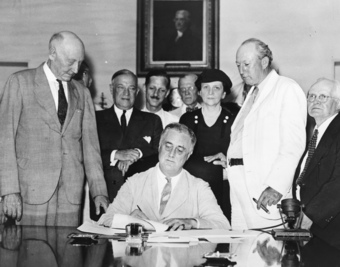
FDR Signs the Social Security Act
President Roosevelt signs the Social Security Act, at approximately 3:30 pm EST on August 14, 1935. Standing with Roosevelt are Rep. Robert Doughton (D-NC); unknown person in shadow; Sen. Robert Wagner (D-NY); Rep. John Dingell (D-MI); unknown man in bowtie; the Secretary of Labor, Frances Perkins; Sen. Pat Harrison (D-MS); and Rep. David Lewis (D-MD).
Social security grew rapidly and is one of the largest government spending initiatives in the United States today. In 1937, OASDI had 53,236 beneficiaries and cost the federal government $1,278,000. In 2008, it had 50,898, 244 beneficiaries and cost the federal government $615,344,000,000. It is largely credited with significantly reducing poverty rates among the elderly. But how does social security work? Social security was designed to redistribute wealth temporarily to help seniors finance their lives post-retirement. The current workforce is taxed, the results of which flow into a special fund designed for social security. Payments are then made to retirees. This is not, however, simple redistribution, as the current workforce contributing to the fund will then retrieve payments once they retire. Thus, it is a cross between a redistribution system and a savings account.
However, the structure of the social security system has put the entire program into serious financial distress. Currently, more money is being taken in by the fund through taxing the current workforce than is being paid out to retirees. However, this will soon change. If the laws governing social security are not changed by 2017, social security will pay out more funds than it takes in. According to analyses of the program, for about twenty years after 2017, the Social Security Trust Fund, or the amount of money that went into a special fund when there was a surplus in revenue, will make up the difference in payments. However, by 2037, the Social Security Trust Fund reserves will be exhausted and payments to beneficiaries will drop to about 75% of what they would have otherwise received.
18.4.2: Intergenerational Conflict
Intergenerational conflict refers to the conflict between older and younger generations as they compete for jobs and resources.
Learning Objective
Discuss the conflict perspective of aging in terms of the generational divide and competition for employment and resources (which equal power)
Key Points
- According to the conflict perspective of aging, generations are competing over jobs.
- The inequities in resource distribution reflect larger disparities in power between generations.
- Whichever generation happens to be middle-aged at any given point in time is the most powerful compared to the old and the young.
- Members of the powerful generation act as gatekeepers for the distribution of resources and powers to be in line with their own interests. Power is therefore maintained by the middle-class, perpetuating their monopoly on resources.
- This perspective of aging derives from larger sociological conflict theory.
Key Terms
- conflict theory
-
A social science perspective that holds that stratification is dysfunctional and harmful in society, with inequality perpetuated because it benefits the rich and powerful at the expense of the poor.
- conflict perspective of aging
-
According to the conflict perspective of aging, generations are competing over jobs. The theory developed in 1980s as unemployment rose dramatically.
Intergenerational conflict plays a key role in the conflict perspective of aging. This social theory suggests that conflict between older and younger generations occurs as they compete for resources and jobs . The conflict perspective of aging is a strand of general sociological conflict theory, which is the theory that sees conflict as a normal aspect of social life rather than as an abnormal occurrence.

At the Intersection of Generation: Conflict or Cooperation?
According to conflict theory, generations of people are in competition with one another for power and resources. Could this occur even at the micro-level?
Conflict theory has three main premises: first, that society is comprised of different groups that compete for resources; second, that despite social attempts to portray a sense of cooperation, a continual power struggle exists between social groups as they pursue their own divergent and competing interests; third, social groups will use resources to their own advantage in pursuit of their own goals, even if it means taking advantage of another group of people.
The conflict perspective of aging thus emphasizes competition between generations. According to the conflict perspective of aging, generations are competing over jobs. The theory developed in 1980s as unemployment rose dramatically. As jobs became increasingly scarce, younger and older generations both felt pressure to compete over available resources, enabling competition between the generational divide. As such, the economic climate of the era in which the theory developed influenced the content of the theory itself.
The conflict perspective of aging is not solely about resource acquisition. Rather, resources stand for power. This perspective on aging maintains that whichever generation happens to be middle-aged at any given point in time is the most powerful compared to the old and the young. Members of the powerful generation act as gatekeepers and orchestrate the distribution of resources and powers to be in line with their own interests, often at the exclusion of the needs of other individuals and generations. Power is therefore maintained by the middle-class, perpetuating their monopoly on resources. This tension, and subsequent competition, is precisely what is addressed by the conflict perspective of aging.
18.5: The Symbolic-Interactionist Perspective on Aging
18.5.1: The Symbolic Interactionist Perspective
The symbolic interactionist perspective posits that age is socially constructed and determined by symbols resembling social interactions.
Learning Objective
Argue that the perception of aging is better either in the United States or in Japan, using Goffman’s theory of social presentation
Key Points
- The notion of age is socially constructed, meaning that it has no universal value. Rather, various cultures ascribe aging with different meanings and values.
- In The Presentation of Self in Everyday Life, Erving Goffman argued that people try to control or guide the impression they create on other people by comporting themselves in specific ways.
- The desire to look younger than one’s biological years is frequently the impetus for cosmetic surgeries that can hide the physical effects of aging. These surgical practices suggest a Goffmanian understanding of social presentation.
- Social value is highly dependent on context and culture. Many Eastern societies associate old age with wisdom and value old age much more than their Western counterparts.
Key Terms
- socially constructed
-
The social construction of age means that there is no inherent cultural meaning to the biological process of aging.
- Erving Goffman
-
Erving Goffman (June 11, 1922 – November 19, 1982) was a Canadian-born sociologist and writer. The 73rd president of American Sociological Association, Goffman’s greatest contribution to social theory was his study of symbolic interaction in the form of dramaturgical analysis. This began with his 1959 book, The Presentation of Self in Everyday Life.
Example
- While in Japan, the elderly hold an esteemed position in society, which is evident from the fact that they celebrate Respect for the Aged Day, in the United States youth is often more highly valued.
The Symbolic Interactionist Perspective and Aging
According to the Symbolic Interactionist Perspective, old age, and aging, are socially constructed and determined by symbols that resemble aging in social interactions. While aging itself is a biological process, the Symbolic Interactionist Perspective posits that the meaning behind being “young” or “old” is socially constructed. This means that there is no inherent cultural meaning attached to the biological process of aging. Rather, cultures imbue youth and age with particular meanings. Given the socially constructed nature of age, there are certain behaviors that people typically associate with certain age groups as being “appropriate” or “acceptable” .

Is this Incongruous?
Given the socially constructed nature of age, there are certain behaviors that people typically associate with certain age groups as being “appropriate” or “acceptable. ” Is this old woman challenging any conventional perceptions about how women of a certain age should behave?
Aging is perceived differently around the world, demonstrating its social construction. Frequently, the average life expectancy in a given region impacts what age counts as “old.” For example, in the United States, where the average life expectancy is over 78 years, one isn’t considered “old” until he or she is in their sixties or seventies. However, in Chad, the average life expectancy is less than 49 years, and people in their thirties or forties are therefore already considered middle-aged or “old.” These variations in people’s perceptions indicate that notions of youth and age are culturally constructed, and that there is no such thing as a universal age at which point one becomes old.
Japanese Perceptions of Aging
In addition to defining terms differently, cultures treat their elderly differently and place different values on age. Many Eastern societies associate old age with wisdom and value old age much more than their Western counterparts. In Japan, adult children are expected to care for their aging parents in different ways than in the United States. 65% of Japanese elders live with their children, and very few live in nursing homes. In Japan, if a youth was to put an aging parent in an assisted living home, the behavior would be considered tantamount to neglect. Cultural norms suggest that parents should move in with their children when they are unable to care for themselves. The Japanese celebration of old age is further illustrated by the existence of Respect for the Aged Day, a national holiday to celebrate elderly citizens.
Western Perceptions of Aging
Japanese perceptions of elders diverge markedly from public perceptions of old age in the United States. Western societies tend to place such an increased value on youth that many people take extreme measures to appear young. A desire to look younger is frequently the impetus for cosmetic surgeries that can hide the physical effects of aging. These surgical practices, combined with huge expenditures on makeup and clothing, suggest a Goffmanianunderstanding of social presentation. Erving Goffman was a sociologist writing in the mid-twentieth century. His most famous work, The Presentation of Self in Everyday Life (1959), argued that whenever individuals come into contact with other people, they will attempt to control or guide the impression that others might have of them by intentionally comporting themselves in different ways. Thus, individuals take sometimes drastic action to control the appearance of their age so that others will perceive them as younger. Significantly, these social interactions occur in a social milieu that values youth. In this light, people try to appear younger to increase their sense of social value.
18.6: Challenges of Aging
18.6.1: Social Isolation
Social isolation is common in elderly populations and refers to a complete or near-complete lack of contact with other people.
Learning Objective
Examine the implications of social isolation and how elderly adults are a susceptible population to the effects
Key Points
- As their health deteriorates and friends and spouses die, elders are at an increased risk for social isolation.
- Social isolation is distinct from loneliness, the latter often being considered to be the subjective counterpart of the former.
- Late life depression is the onset of depression for the first time in a person over sixty years of age.
- Consequences of social isolation can be dangerous, particularly for individuals already predisposed to health problems. Studies have demonstrated that seniors who are socially isolated seniors are less likely to take advantage of health and social services
Key Terms
- social isolation
-
Social isolation refers to a complete or near-complete lack of contact with society. It is usually involuntary, making it distinct from isolating tendencies or actions taken by an individual who is seeking to distance himself from society.
- late life depression
-
Late life depression is the onset of depression for the first time in a person over sixty years of age.
- loneliness
-
The condition of being lonely; solitude; seclusion.
Human beings, by nature, are social creatures. Throughout the socialization process, we become accustomed to living in groups and interacting with others. Individuals in every society, however, at times must cope with social isolation, which is defined as a complete or near-complete lack of contact with others in society. Social isolation is usually involuntary, making it distinct from the isolating tendencies some individuals may have that lead them to purposefully distance themselves from others.
Social isolation is also distinct from loneliness. Loneliness is a subjective experience associated with a temporary lack of contact with other humans. Social isolation, by contrast, can be objectively measured in terms of a person’s social contacts and relationships.
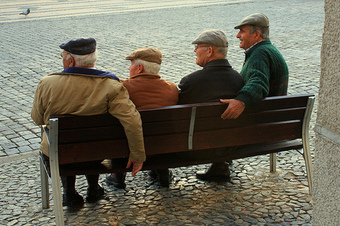
Friends
Maintaining friendships and building relationships is an important aspect of old age that wards off social isolation.
Any individual from any segment of society may be socially isolated, but senior citizens are especially susceptible to the risk factors that may trigger social isolation. These include living alone, family violence, loss of a spouse, aging-related cognitive impairments and disabilities, and transport issues. Consequences of social isolation can be dangerous, particularly for individuals already predisposed to health problems. Studies have demonstrated that seniors who are socially isolated seniors are less likely to take advantage of health and social services. This indicates a circularity of social isolation and health: individuals who are already marginalized are not pushed toward healthcare and individuals with quickly deteriorating health are more likely to be socially isolated. Extended social isolation can contribute tolate life depression, which is a major depressive episode occurring for the first time in an individual over sixty years of age.
Social isolation is a larger problem for elders now than in the past, due to the decreasing size of families in Western countries. In the past, elders were not at increased risk for social isolation because they would move in with their children. Now, many elders are moved into elder homes with less frequent contact with their children. However, many elder homes and retirement facilities are working to combat social isolation by increasing programming for their residents.
18.6.2: Prejudice
Ageism is the discrimination of groups because of their age, and applies especially to the elderly.
Learning Objective
Examine the concept of ageism and the impact of stereotypes for elderly adults
Key Points
- Elders frequently encounter prejudice as others assume stereotypes about them to be true.
- The idea of ageism was developed by gerontologist Robert Neil Butler.
- Prejudices most frequently surface in the course of medical treatment and in the workplace.
Key Terms
- term limit
-
A legal restriction that limits the number of terms a person may serve in a particular elected office.
- ageism
-
The treating of a person or people differently from others based on assumptions or stereotypes relating to their age.
Example
- Ageist attitudes typically depict older adults to be infirm, sedentary and generally incapable of leading an active and exciting lifestyle. Mickey Hart, one of the two drummers of the iconic rock band, the Grateful Dead, is one of many examples that contradicts this image of “older people. ” At age 68, Hart continues to perform and tour the country and, as of 2006, became a part of a new band known as the “Rhythm Devils. “
Ageism
Ageism is the stereotyping and discrimination against individuals or groups because of their age. Ageism can be applied to discrimination against any age group, such as discrimination against teenagers, but this section will focus on ageist discrimination against seniors. The term was coined in reference to discriminatory practices against the elderly by gerontologist Robert Neil Butler. He coined the term by intentionally mirroring it after other forms of discrimination, such as sexism or racism.
Stereotypes of the Elderly
Many people are prejudiced against seniors, beginning with the common stereotypes of older adults . Old people are frequently assumed to be in poor physical or mental health and lack psychological agility. It is a common presumption that, as people age, they become more inflexible and conservative in their opinions. Older adults are frequently presumed to be poor drivers. In fact, studies have demonstrated that older drivers, up until the age of about 75, are actually safer drivers than young drivers. Unfortunately, elder patients are frequently discriminated against in the course of medical treatment due to stereotypes based on their age. Studies have demonstrated that elder patients are less likely to have their medical care explained to them, partially because physicians assume that they are unable to understand medical complexities.

Age is just a Number
This man clearly defies ageist perceptions of older people as being physically infirm and weak.
Elderly Prejudice in the Workplace
Older adults commonly encounter prejudice in the workplace. It is frequently assumed that an elderly person is mentally inept and incompetent. Employment discrimination, or the presence of discrimination against a targeted group in the workplace, manifests in two different ways vis-à-vis elderly workers. Individuals who began working for a company in their younger years can be pushed out as they age. This process refers to company management redirecting clients away from the older employees and toward the younger employees.
Alternatively, companies may not hire older employees to begin with. Joanna Lahey, a professor at the Bush School of Government and Public Service at Texas A&M University, has found that firms are 40% more likely to give a hiring interview to a younger candidate than to an older candidate. This suggests that firms are more interested in hiring younger employees than older employees. The government has tried to combat age discrimination through laws such as the federal Age Discrimination in Employment Act of 1967 which forbids employers from discriminating against employees over the age of forty. This goes against the age stratification theory of society, which states the unequal distribution of wealth, power and privileges among people at different stages in the life course. According to age stratification theory, younger and older people should be a disadvantages due to their position in life, whereas middle-age people would be at at advantage.
Aging and its impact on the workforce is also an issue for certain sectors of government. The issue has been highlighted as it pertains to the United States Supreme Court. Justices at the Supreme Court are given lifetime appointments, meaning that they do not have to retire or step down from the bench until they choose to or until their deaths. However, as in any other workplace, the potential senility of aging Supreme Court justices has been hotly debated.
Former Chief Justice William Rehnquist, for example, was appointed to the Supreme Court in 1986 and served until his death in 2005. He was only weeks shy of his eighty-first birthday when he died and had been in declining health for the last few years of his life. Treatment for anaplastic throat cancer forced him to miss many arguments in the year before his death. Rehnquist’s death reignited a political debate about instating term limits for Supreme Court justices in place of lifetime appointments, such that a justice would be forced to retire after a certain number of years. There are many political and legal reasons supporting both sides of the debate, but assumptions about the declining health of older justices, many of whom serve on the court into their seventies, play a prominent role in the discussion.
18.6.3: Elder Abuse
Elder abuse is the use of physical or mental harm against people of an older age.
Learning Objective
Analyze the various types of elder abuse and the implications each has for an elderly person’s quality of life
Key Points
- Elder abuse is an umbrella term that refers to all types of abuses against older adults perpetrated by trusted individuals upon whom these elderly people typically depend.
- Domestic elder abuse is committed by an elder’s family or friends, while institutional elder abuse is committed by employees at facilities and institutions designated to take care of elders.
- Grooming occurs when friends or neighbors build relationships of trust with elders in order to gain control of their finances.
Key Terms
- grooming
-
Grooming occurs when friends or neighbors build relationships of trust with elders in order to gain control of their finances.
- domestic elder abuse
-
Domestic elder abuse is committed by an elder’s family or friends.
- institutional elder abuse
-
Institutional elder abuse is committed by workers at residential facilities for elders, such as nursing homes.
Elder abuse is an umbrella term that refers to harm done to older adults. Typically, the harm is committed through intentional or neglectful acts by a caregiver or “trusted” individual that cause physical or emotional harm. A significant factor that distinguishes elder abuse from other types of harmful behavior involves the commission of harms where there is an expectation of trust extending from the older person to his abuser .
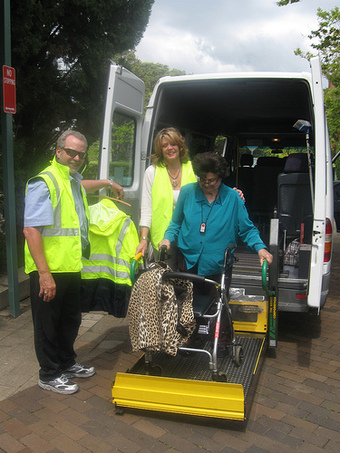
Elder Abuse
Imagine if the people elders depended on the most, such as these community transport service workers, were to breach that trust and abuse them.
Types of Elder Abuse
Elder abuse is illegal; special protections have been established to protect elders who are dependent upon others. However, because elder abuse is such a wide-reaching term, it can be difficult for different jurisdictions to define the term for legal usage. The main types of elder abuse include physical abuse, emotional abuse, financial abuse, sexual abuse, and neglect. Physical abuse of elders includes the hitting, punching, slapping, burning, pushing, kicking, restraining, or false imprisonment of elders. Additionally, giving an elder excessive or improper medication qualifies as physical abuse.
Emotional abuse includes shouting, swearing, frightening, or humiliating an elder. Financial abuse is the illegal or unauthorized use of a person’s property, money, pension, or will. Sexual abuse for elders is when an elder is forced to take part in any sexual activity, including participating in conversations of an unwanted sexual nature. Elders with dementia may not be able to consent to any sexual activity whatsoever. Neglect includes depriving an elder of food, heat, clothing, or essential medication. Deprivation may be active or passive, occurring intentionally or from a lack of knowledge. Elder abuse is further subdivided into domestic elder abuse and institutional elder abuse. Domestic elder abuses are committed by family and friends of an older person; institutional elder abuse is committed by workers at residential facilities for elders, such as nursing homes.
Grooming
Regardless of whether the perpetrator is a family member, friend, or institutional caretaker for an older person, a central theme throughout all of these different types of abuses is the relationship of dependency of elders with those who care for them. Serious offenses can be committed by abusive groomers through grooming an older person by befriending him or her in order to build trusting relationships that can then be exploited. Older people living with no adult children nearby are particularly vulnerable to grooming by neighbors and friends who might seek to gain control of their estates. Unfortunately, the nature of dependency inherent to elder abuse can make cases of elder abuse especially difficult to prosecute. For example, an elder might not believe that someone close to him is taking his money or might be persuaded to report that he wanted it as such, when this wasn’t the case. Elders are a particularly vulnerable population because they are dependent upon others and may even be senile, which makes it easier for them to be manipulated.
Consequences of Elder Abuse
Elder abuse can have serious consequences. Elder abuse can destroy a victim’s quality of life by limiting his functional abilities, increasing dependency, increasing his sense of helplessness, increasing stress, worsening his psychological decline, inducing dementia, and risking malnutrition or overmedication. Elder abuse can even result in death.
Of course, the horrible consequences listed above can arise directly from the physical abuse of a victim. Additionally, while an elder may be too senile to comprehend the abusive relationship, stress can seep through his lack of comprehension and perpetuate and even exacerbate preexisting health problems. The risk of death for elder abuse victims is three times higher than for non-victims.
18.6.4: Health Problems
Although health problems rise when one comes into older age, social effects also exacerbate of medical ailments by the elderly.
Learning Objective
Discuss the health issues associated with aging, such as heart disease, cancer and neuropsychological disorders
Key Points
- As we age, we experience health problems with greater frequency.
- Cardiovascular problems, cancer, and dementia are common problems for the elderly.
- Geriatrics is a field of medicine that concentrates on treating the medical problems of older adults.
- An elderly person’s social environment has serious consequences on the type of care received and the effect it has on the individual’s health.
Key Terms
- geriatrics
-
The branch of medicine that focuses on health promotion and the prevention and treatment of disease and disability in later life. The term itself can be distinguished from gerontology, which is the study of the aging process itself.
- arteriosclerosis
-
Hardening, narrowing or loss of elasticity in arteries or blood vessels.
- dementia
-
A progressive decline in cognitive function due to damage or disease in the brain—beyond what might be expected from normal aging. Areas particularly affected include memory, attention, judgement, language and problem solving.
As we age, we face more and more health problems. According to the Centers for Disease Control and Prevention, the leading causes of death for Americans are heart disease and cancer. Statistically, heart disease and cancer account for the most American deaths by far. In 2009, heart disease claimed 599,413 lives and cancer was responsible for 567, 628 deaths. Of course, these numbers include all ill individuals, not just the elderly.
Heart Disease
Because of the prevalence of heart disease and cancer among the elderly, many American hospitals have developed programs to treat seniors with these particular afflictions. Geriatrics is the field of medicine that specializes in treating older adults. Cardiogeriatrics refers to the branch of healthcare that treats heart disease in older adults. Heart disease is common in seniors because as one ages, one’s heart muscle begins to weaken and change in adverse ways. As the heart ages, one can develop arteriosclerosis, or the stiffening of arteries due to the accumulation of fatty buildup, or plaque, along the walls of the arteriesm, restricting blood circulation. Arteriosclerosis is common to older adults that contributes to congestive heart failure. This is the condition defined by the inability of the heart to provide adequate blood flow to the body.
Congestive heart failure is common, costly, disabling, and potentially deadly. In developed countries, around 2% of adults suffer from heart failure. Risk rises with age. In developed countries, 6–10% of adults over the age of 65 suffer from congestive heart failure. Congestive heart failure increases the risk that one will experience a myocardial infarction, or heart attack.
In a heart attack, blood supply to the heart is interrupted, causing damage to the heart muscle. When blood flow is stopped from going to the brain, usually due to a blood clot, one suffers from a stroke. Americans have more than 700,000 strokes every year, making it the third leading cause of death in the United States after heart disease and cancer. Nearly 75 percent of strokes occur in people over the age of 65, and the risk of having a stroke more than doubles during each decade between the ages of 55 and 85.
Cancer
Other than cardiovascular diseases, cancer is the most common, serious illness faced by the elderly. While anyone can develop cancer, the risk of getting certain cancers increases with age. Breast, colorectal, prostate, pancreatic, lung, bladder, and stomach cancers are especially linked to aging. Cancer can be even more difficult to treat in the elderly than in younger patients because treatment can be stressful on the body. Treating cancer involves some combination of radiation, chemotherapy, or surgery, all of which are more stressful on an aged body than a younger body. Recognition of the stress that treatment may have on an older body limits the options available for treatment.
Neuropsychological Disorders
Older adults are also more susceptible to certain neuropsychological disorders, such as dementia and Alzheimer’s disease, that are virtually unseen in younger populations. Dementia is a serious loss of global cognitive ability in a previously unimpaired person—beyond what might be expected from normal aging. It may be static—the result of a unique brain injury—or progressive—resulting in long-term decline due to damage or disease in the body. Dementia is not a single disease, but rather a syndrome that is associated with a variety of different diseases, such as Alzheimer’s. Symptoms of Alzheimer’s include confusion, irritability, aggression, mood swings, difficulty with language, and memory loss. Most often, Alzheimer’s disease is diagnosed in people over the age of 65. In 2006, there were 26.6 million sufferers worldwide. One in eight Americans over the age of 65 suffers from Alzheimer’s and that number is set to rise in future years as the average lifespan continues to rise.
Obviously, aging presents serious concerns about health. A person’s body is more likely to encounter disease as he or she ages. Frequently, preexisting medical ailments are exacerbated by social determinants of health. Social determinants of health are the extra-biological factors that influence how individuals experience their own health. For example, congestive heart failure does not necessarily kill someone. However, the patient with congestive heart failure is most likely going to be put on a complicated medication regime. Congestive heart failure combined with dementia—or even normal forgetfulness associated with aging—makes adhering to a strict regimen difficult for many older adults. The elderly are frequently dependent on younger adults for assistance. The types of care to which the elderly have access can have serious medical consequences.
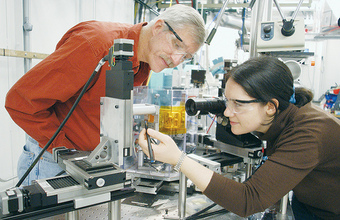
Studying Alzheimer’s Disease in the Argonne National Laboratory
Mark Davidson (left), University of Florida, and Joanna Collingwood, Keele University, scrutinize a sample of Alzheimer’s brain tissue.
